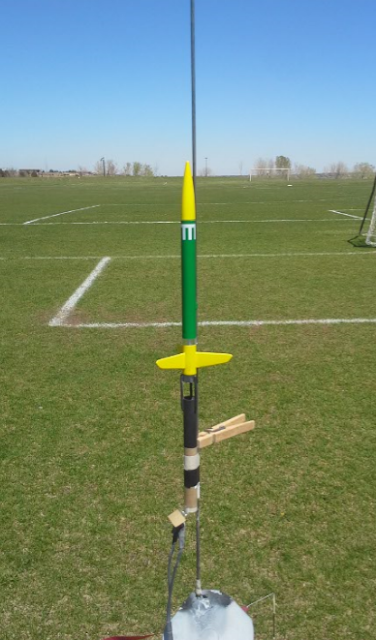Arriving at Dove Valley around 11:00 a.m , I found the conditions to be near perfect - wind at 0 to 5 mph, temperature close to 70 degrees, and a clear blue Colorado sky. The field was in great condition as well, albeit a little damp from recent rains and/or park watering.
Mission #1
As you blog followers well know, the very first model flown at all of my launch sessions is the old Estes Mini-Brute Hornet. It's my marker bird for assessing wind drift conditions, plus I'm shooting for that magical 100-flight mark. This will be launch #32. A long ways yet to go!
The Hornet boosted nice and straight on an A3-4T engine, deployed its 8" parachute and drifted down, landing 40 feet from the launch pad. Excellent flight. So far, so good!
Mission #2
The next bird to be prepped was the 'old fleet' Delta II and recently completed payload section. The last time the Delta II booster was flown was 25 April, 1981!
Launched
 on a B4-4 engine, the model did one of those cool slow ,straight liftoffs. Reaching altitude, it deployed its 12" parachute and descended nicely, landing 50 feet from the launch area. A great performance from a vintage bird.
on a B4-4 engine, the model did one of those cool slow ,straight liftoffs. Reaching altitude, it deployed its 12" parachute and descended nicely, landing 50 feet from the launch area. A great performance from a vintage bird.Mission #3
I quickly prepped the Delta II for a second flight, again on a B4-4 engine. For this launch, I taped on a launch lug at the fore end of the booster to accommodate a recently constructed Estes Firefly parasite glider.
After a few dozen hand tosses, I had the glider trimmed reasonably well. These models are a bit tricky to balance and trim, having a small delta wing with a small aspect ratio.
The tandem boosted nicely, with the ejection charge occurring right at apogee.
To my chagrin, the model began descending with no parachute deployment. The payload section had just barely popped off of the carrier tube. I also noted that the Firefly was still attached.
I watched the whole mess free-fall, fearing the worst. At least the entire rocket had assumed a horizontal position during its descent, so the 'crash' wasn't as severe as it had the potential to be.
Upon recovery, I was delighted to discover that the Delta-II had sustained no damage whatsoever. The Firefly's attachment pin had broken off on the impact, but that is an easy repair. Phew! Dodged a bullet, here.
A post-flight inspection revealed the cause of the malfunction. Apparently, the recovery wadding from the first flight had not ejected from the tube. I hadn't noticed this while prepping for the second flight, so I stuffed another load of wadding in. This was simply too much stuff for the B4 engine to eject. It only had enough "Ooomph'" to dislodge the payload section. This also explains why the Firefly did not separate. There was not enough ejection kick-back going on.
 |
| Too much wadding...and, oh, the burnt smell! |
It was bound to happen....
The first spectacular model rocket crash of my BAR career.
The final launch of the day was a second test of the Open Air Gap Staging booster.
The hapless victim of this event was the Centuri Star Trooper clone.
The AGS booster was loaded with an A10-0T engine, and was attached to the launch rod via a clothespin. It was not intended to fly - only to remain on the pad and ignite the upper stage engine.
Sitting atop the booster was the Star Trooper, equipped with an A10-3T. It would be nice if Estes made an A10 with a 5 or 6 second delay for upper stage work, but I will have to roll with what's available.
At ignition, the model completely dislodged the clothespin, and the whole thing took off on ballistic flight. Since the booster section does not have any fins, you can imagine what happened next.
The model boosted to about 30 feet in extremely unstable flight.
 |
The beginning of a bad flight. That's the clothespin
next to the exhaust plume that should have been
holding the booster on the pad... |
The resulting power prang was brutal!
With the model sticking in the turf about fifty feet from the launch pad, the delay charge burned, and the ejection charge shot the engine out the model's tail. I found the casing about 40 feet away from the crash site.
Damage to the Trooper consisted of two completely missing fins, a missing forward launch lug, and a lot of dings and dirt smudges on the airframe.
The bird is actually salvageable and will be re-built to fly another day!
After a five minute search, the AGS booster was found. No damage at all.
Despite this disastrous outcome, the original mission objective was successfully accomplished: Iginition of the upper stage from an open air gap booster!
The next step in the project is to add fins and finish to the booster section, repair the Trooper, and fly the tandem again in normal staging configuration.
Stay tuned.
With only a 50% success rate for the flight session, I packed up and bade farewell to Dove Valley Park....






No comments:
Post a Comment